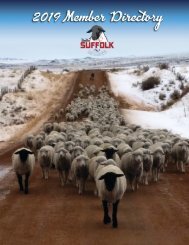2018 Suffolk Directory
You also want an ePaper? Increase the reach of your titles
YUMPU automatically turns print PDFs into web optimized ePapers that Google loves.
History of the <strong>Suffolk</strong> Breed<br />
The <strong>Suffolk</strong> breed, an original English<br />
breed, was the result of crossing Southdown<br />
rams on Norfolk Horned ewes. The product of<br />
this cross was determined to be a great<br />
improvement over either one of the parents.<br />
Although the <strong>Suffolk</strong> was a recognized breed<br />
as early as 1810, the flock book was not closed<br />
until much later.<br />
In 1930, Southdowns were described as<br />
large sheep without horns, dark faces and legs,<br />
fine bones and long small necks. They were<br />
gray to mouse brown on the face and legs.<br />
They were low set in front with high shoulders<br />
and light forequarters; however, their sides<br />
were good, rather broad in the loin and were<br />
full in the thigh and twist. Today's <strong>Suffolk</strong><br />
derives its meatiness and quality wool from the<br />
old original British Southdown.<br />
The Norfolk Horned sheep, now rare, were<br />
a wild and hardy breed. They were black faced,<br />
light, fleeced sheep. Both sexes were horned.<br />
The upland regions of <strong>Suffolk</strong>, Norfolk and<br />
Cambridge on the southeastern coast of<br />
England are very rugged and forage is sparse.<br />
It was this dry, cold and windy area in which the<br />
Norfolk breed adapted itself to traveling great<br />
distances for food, thereby developing a<br />
superbly muscular body.<br />
It was said at that time of the Norfolk<br />
Horned, "their limbs are long and muscular,<br />
their bodies are long and their general form<br />
betokens activity and strength." This breed and<br />
its crosses were valued highly both by farmers<br />
and butchers. However, sheepmen of that day<br />
did not like the long legs, flat sides, nor wild<br />
nature of the Norfolk Horned. They noted that<br />
Southdowns crossed with Norfolks produced a<br />
progeny that reduced most<br />
of the criticisms of both<br />
breeds.<br />
In 1886, the English<br />
<strong>Suffolk</strong> Society was organized<br />
to provide registry<br />
service and to further<br />
develop the use of the<br />
breed. Through selection<br />
and careful breeding by<br />
many great English sheepmen,<br />
the <strong>Suffolk</strong> brought to<br />
this country retained the<br />
qualities for which they<br />
were originally mated.<br />
The first <strong>Suffolk</strong>s were<br />
brought to this country in<br />
1888 by Mr. G.B. Streeter of<br />
Chazy, New York. During a<br />
visit to England the previous year, Mr. Streeter<br />
had been greatly impressed by <strong>Suffolk</strong> sheep.<br />
These prize breeding animals had belonged to<br />
Joseph Smith of Hasketon, and one 21 month<br />
old ewe weighed exactly 200 pounds when she<br />
came off the ship. A 9 month old ram weighed<br />
195 pounds and in the spring of 1890, a 7 week<br />
old twin weighed 85 pounds. That spring,<br />
Streeter had a 200% lamb crop.<br />
The <strong>Suffolk</strong> did not make its appearance in<br />
the western states until 1919. Three ewes and<br />
two rams had been donated by the English<br />
<strong>Suffolk</strong> Sheep Society to the University of<br />
Idaho. One of the rams was to be sold at auction<br />
at the National Ram Sale in Salt Lake City,<br />
Utah.<br />
Several leading sheepmen saw these<br />
sheep at the sale and they liked what they saw.<br />
After several rounds of bidding, the ram was<br />
finally sold to Laidlaw and Brockie (developers<br />
of the Panama breed) of Muldoon, Idaho, for<br />
$500. These men were so impressed with the<br />
offspring from their <strong>Suffolk</strong> ram that they made<br />
several inportations and were consistent buyers<br />
at the National Ram Sale.<br />
SUFFOLK TRAITS<br />
Mature weights for <strong>Suffolk</strong> rams range from<br />
250 to 350 pounds (113-159 kg), ewe weights<br />
vary from 180 to 250 pounds (81-113 kg).<br />
Fleece weights from mature ewes are between<br />
five and eight pounds (2.25-3.6 kg) with a yield<br />
of 50 to 62 percent. The fleeces are considered<br />
medium wool type with a fiber diameter of 25.5<br />
to 33.0 microns and a spinning count of 48 to<br />
58. The staple length of <strong>Suffolk</strong> Fleece ranges<br />
from 2 to 3.5 inches (5-6.75 cm).<br />
United <strong>Suffolk</strong> Sheep Association<br />
Director Districts<br />
WA<br />
ME<br />
AK<br />
OR<br />
ID<br />
DISTRICT 1<br />
NV<br />
UT<br />
CA<br />
AZ<br />
ND<br />
MT<br />
SD<br />
WY<br />
NE<br />
CO<br />
KS<br />
DISTRICT 2<br />
OK<br />
NM<br />
MN<br />
NY<br />
WI<br />
MI<br />
DISTRICT 3<br />
PA<br />
IA<br />
DISTRICT 4 MD<br />
IN<br />
IL<br />
OH<br />
WV<br />
VA<br />
MO<br />
KY<br />
NC<br />
TN<br />
AR<br />
SC<br />
MS AL GA<br />
VT<br />
NH<br />
MA<br />
CT<br />
RI<br />
NJ<br />
DE<br />
HI<br />
TX<br />
LA<br />
FL<br />
<strong>2018</strong> SUFFOLK DIRECTORY PAGE 5





